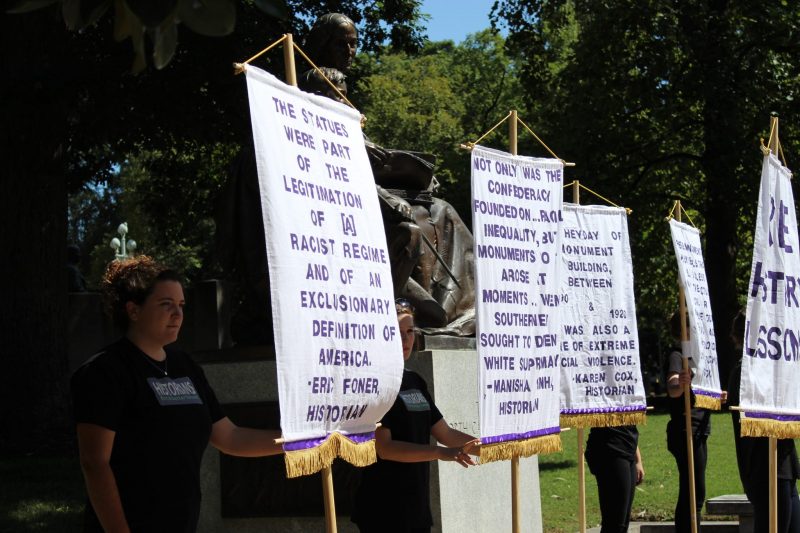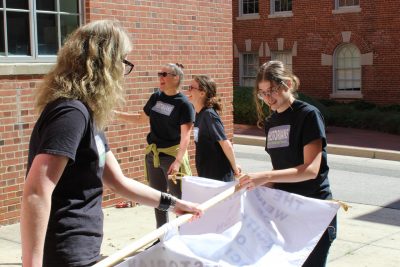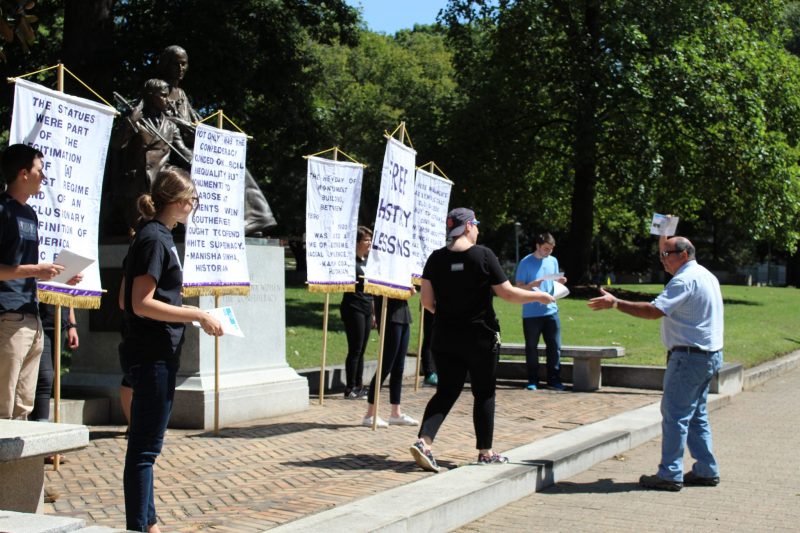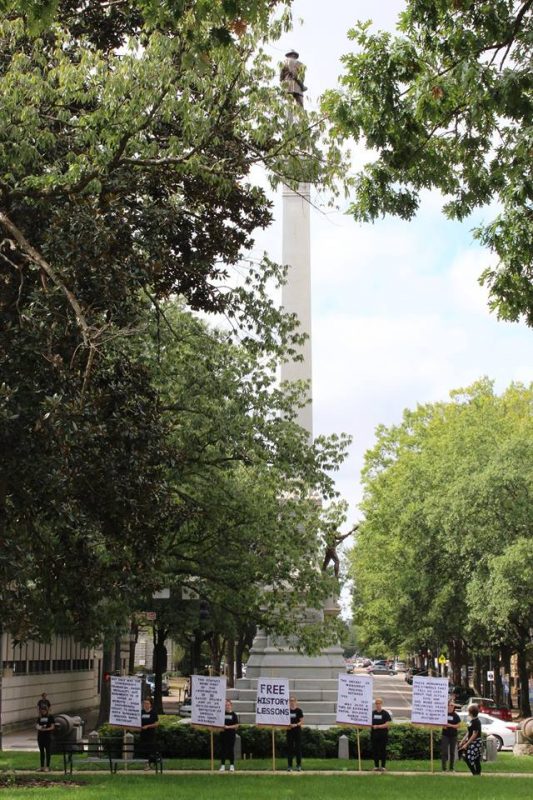Q: “Sir, would you like a history of this monument?” A: “F**k You!”
21 March 2018 – HIstorians for a Better Future
Members of Historians for a Better Future planned to encounter many personalities along the sidewalk when we set up in front of the Women of the Confederacy monument at the State Capitol building in Raleigh, North Carolina, on September 8, 2017. During our Free History Lesson, we stood holding banners connecting the monument to white supremacy and passing out histories. When one of our educators approached a passerby with an offer of a free historical brochure, he received a decided “F**k you.” But other educators reported finding common ground with most individuals, and some pedestrians expressed encouragement. Motorists used horns and hand gestures to express disappointment or support for our work. Such a range of responses not only indicate the charged climate for public dialogue about history, but also how, in this volatile time, education looks very much like protest.

Historians for a Better Future demonstrate in Raleigh, North Carolina. Photograph by Matthew Champagne.
Ninety monuments memorialize the Confederacy in North Carolina, most built between 1890 and 1920 as the state enacted Jim Crow laws and cemented white supremacy into the physical landscape.[1] In July 2015, as debate over Confederate iconography increased after the massacre at Emanuel African Methodist Episcopal Church in Charleston, South Carolina, the North Carolina General Assembly passed the Historic Artifact Management and Patriotism Act, which severely limited the circumstances in which Confederate monuments and memorials could be removed or relocated. The law gave the North Carolina Historical Commission sole authority over removing, relocating, or altering all monuments, memorials, and works of art owned by the state, and required that communities and public universities acquire state approval before removing or even altering monuments. The law also prohibits the removal of objects of remembrance “to a museum, cemetery, or mausoleum unless it was originally placed at such a location.”[2]
Following the events in Charlottesville, Virginia, in September 2017 North Carolina Governor Roy Cooper petitioned the Historical Commission to remove three Confederate monuments currently on the Capitol Grounds in Raleigh to Bentonville Battlefield, a state-owned historic site fifty miles south of the city. At their September meeting, the Commission delayed deciding upon Cooper’s request, unsure what authority the law provides them.
Created by public historians in Raleigh in early 2017, Historians for a Better Future addresses these issues through a series of programs to share historians’ research connecting Confederate monuments to white supremacy. Our Free History Lessons operate on several different levels. We draw on the decorative style of World War I “Silent Sentinels” protests by suffragettes, which is reminiscent of the same time period these monuments were erected, but also subtly argues that, like these women, historians can and should enter the public sphere.

Members of Historians for a Better Future prepare their banners. Photo credit: Matthew Champagne.
Our signs also operate like museum labels, by recontextualizing Confederate monuments. The banners initiate conversations and provide easily shareable images for social media. Educators then use the handouts to guide the conversation, provide information, and encourage participants to critically consider the role of Confederate monuments in society. They also provide participants with a reading list, a tangible product they can take with them.
Group members formed a research committee to develop the pamphlets used during each Free History Lesson. The team contextualized the history of each monument and addressed the monuments’ symbolism to illustrate how their iconography reinforced white supremacy or celebrated Confederate leaders. We did not want the pamphlets to only highlight our own primary source research but to make our audience aware of other scholars’ work.
Due to a quick turnaround in response to the events in Charlottesville, the first Free History Lesson pamphlet focused primarily on monument quick facts, symbolism, and readings. We expanded the scope for the second Free History Lesson to include North Carolina in the Civil War, Lost Cause mythology, Confederate monuments in the South, and an overview of the public debate with emphasis on the American Historical Association’s stance on monuments as interpretation, not history. Information specific to the monument was included as an insert.
Given the symbolism of Confederate monuments for white nationalists and the violence at Charlottesville, we recognized and trained for the possibility of direct confrontation. We proposed our event plan to a self-defense specialist, one from our community who had experience with white violence, and he volunteered to lead a training session based on our modified “Silent Sentinels” approach. We practiced remaining calm when confronted, using our signs for protection, and implementing techniques for de-escalation. We defined our roles so that each individual had discrete responsibilities. Sentinels held signs and educators interacted with passersby and kept an eye on the sentinels in case they needed a break or found themselves confronted. In addition, a manager started and stopped the event and monitored for any possible safety issues, while a recorder documented.

Passersby receive a Free History Lesson from Historians for a Better Future. Photo credit: Matthew Champagne
The event required permits granted by the North Carolina Department of Administration, which took about ten days to process. The police department made repeated calls to ask about us, our signs, and our plans; these calls eventually ended after a conversation about commemorative decorative arts in the period between 1880 and 1930. During the first event, three police cars parked across the street from the monument. Other patrol cars circled the block.
During our first teaching event, reactions indicated more anger but also more precise comprehension of our message, probably because we faced the street and sidewalk so our signs were easily visible to passersby. Our close proximity to the monument itself also facilitated the communication of our message.

Historians for a Better Future demonstrate near the “To Our Confederate Dead” monument in Raleigh, NC. Photo credit: Matthew Champagne
However, during our second teaching event at the 1895 To Our Confederate Dead monument, we were unable to face the street. Pedestrians approached from multiple angles and distances, stretching our educators and sentinels farther apart than at the first event. Consequently, many individuals engaged with us more hesitantly and suspiciously. Educators had many fruitful engagements, but also overheard passersby expressing confusion about our message. Several people assumed we advocated in favor of keeping the monuments. These comments showed us we have to design future events so that people must read the signs.
Historians for a Better Future plans to offer additional Free History Lessons at the State Capitol in Raleigh, particularly during the time leading up to the North Carolina Historical Commission meeting in April 2018, at which the fate of the three monuments will be decided. HBF will also collaborate with the Durham Heritage Alliance on a program to facilitate community decision-making on the status of the empty pedestal from which Durhamites removed the Confederate Soldiers Monument in August 2017.
Free History Lessons will continue to focus on the importance of accurate historical knowledge in the decisions of the present. With Free History Lessons, we demonstrate that education is activism. Public historians have the skill set to engage with members of the community and provide a more nuanced understanding of the past and how the past informs the present. This can take many forms, but getting on the sidewalk and giving people the opportunity to say “f**k you” should be a foundational pillar of what it means to do public history.
~ Matthew Champagne, Tammy Gordon, Katie Schinabeck, Sarah A. M. Soleim, and Lisa R. Withers. The authors are public historians based at North Carolina State University and are founding members of Historians for a Better Future.
[1] This number is drawn from “Whose Heritage? Public Symbols of the Confederacy,” The Southern Poverty Law Center, April 21, 2016, https://www.splcenter.org/20160421/whose-heritage-public-symbols-confederacy.
[2] S.L. 2015-170, Sess. of 2015-2016 (N.C. 2015), https://www.ncleg.net/gascripts/BillLookUp/BillLookUp.pl?Session=2015&BillID=s22.




How many Civil War UNION memorials are there, nationwide, compared to Confederate memorials? I’m betting that the number of Confederate memorials dwarfs the union ones. Are there any memorials in the South to the thousands of Southerners who joined the UNION ARMY (Lincoln’s Loyalists)? I’m betting there are none.
Ten seconds of research would show you that you would lose that bet.
https://en.wikipedia.org/wiki/List_of_Union_Civil_War_monuments_and_memorials#Virginia
There is at least one, South of the Mason Dixon line, at “Thomas Circle” in DC.
A Virginian who fought for the Union.
I’m a NC native and I am absolutely floored by your techniques. Thank you!
Thank you for what you are doing. Such important work!
My spouse and I absolutely love your blog and find the majority of your post’s to
be just what I’m looking for. Does one offer guest
writers to write content for yourself? I wouldn’t mind publishing a post or elaborating on a lot
of the subjects you write concerning here. Again, awesome web log!